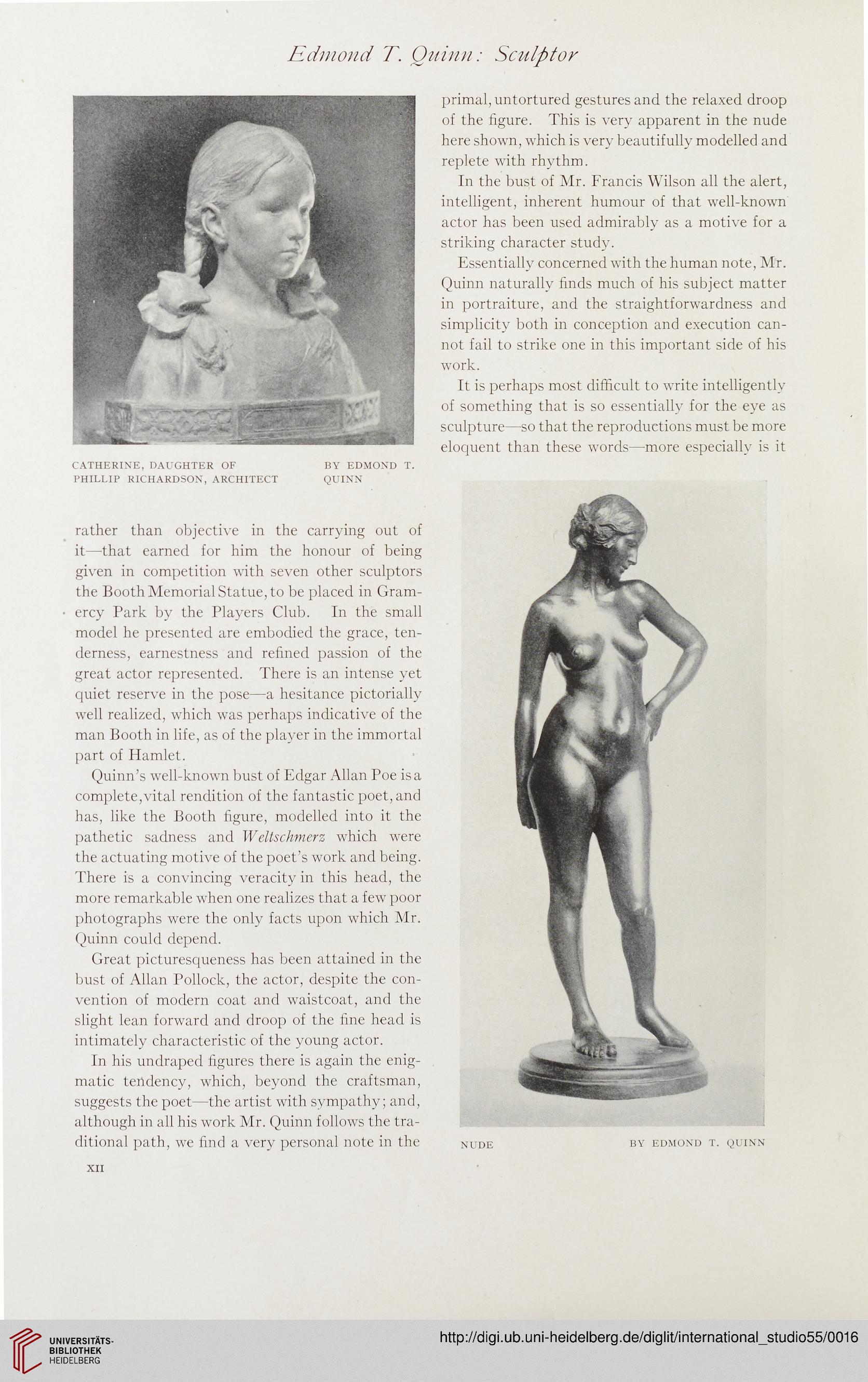Edmond T. Quinn: Sculptor
CATHERINE, DAUGHTER OF
PHILLIP RICHARDSON, ARCHITECT
BY EDMOND T.
QUINN
rather than objective in the carrying out of
it—that earned for him the honour of being
given in competition with seven other sculptors
the Booth Memorial Statue, to be placed in Gram-
ercy Park by the Players Club. In the small
model he presented are embodied the grace, ten-
derness, earnestness and refined passion of the
great actor represented. There is an intense yet
quiet reserve in the pose—a hesitance pictorially
well realized, which was perhaps indicative of the
man Booth in life, as of the player in the immortal
part of Hamlet.
Quinn’s well-known bust of Edgar Allan Poe is a
complete,vital rendition of the fantastic poet, and
has, like the Booth figure, modelled into it the
pathetic sadness and W eltsdvmerz which were
the actuating motive of the poet’s work and being.
There is a convincing veracity in this head, the
more remarkable when one realizes that a few poor
photographs were the only facts upon which Mr.
Quinn could depend.
Great picturesqueness has been attained in the
bust of Allan Pollock, the actor, despite the con-
vention of modern coat and waistcoat, and the
slight lean forward and droop of the fine head is
intimately characteristic of the young actor.
In his undraped figures there is again the enig-
matic tendency, which, beyond the craftsman,
suggests the poet—the artist with sympathy; and,
although in all his work Mr. Quinn follows the tra-
ditional path, we find a very personal note in the
primal, untortured gestures and the relaxed droop
of the figure. This is very apparent in the nude
here shown, which is very beautifully modelled and
replete with rhythm.
In the bust of Mr. Francis Wilson all the alert,
intelligent, inherent humour of that well-known
actor has been used admirably as a motive for a
striking character study.
Essentially concerned with the human note, Mr.
Quinn naturally finds much of his subject matter
in portraiture, and the straightforwardness and
simplicity both in conception and execution can-
not fail to strike one in this important side of his
work.
It is perhaps most difficult to write intelligently
of something that is so essentially for the eye as
sculpture—so that the reproductions must be more
eloquent than these words—more especially is it
NUDE BY EDMOND T. QUINN
XII
CATHERINE, DAUGHTER OF
PHILLIP RICHARDSON, ARCHITECT
BY EDMOND T.
QUINN
rather than objective in the carrying out of
it—that earned for him the honour of being
given in competition with seven other sculptors
the Booth Memorial Statue, to be placed in Gram-
ercy Park by the Players Club. In the small
model he presented are embodied the grace, ten-
derness, earnestness and refined passion of the
great actor represented. There is an intense yet
quiet reserve in the pose—a hesitance pictorially
well realized, which was perhaps indicative of the
man Booth in life, as of the player in the immortal
part of Hamlet.
Quinn’s well-known bust of Edgar Allan Poe is a
complete,vital rendition of the fantastic poet, and
has, like the Booth figure, modelled into it the
pathetic sadness and W eltsdvmerz which were
the actuating motive of the poet’s work and being.
There is a convincing veracity in this head, the
more remarkable when one realizes that a few poor
photographs were the only facts upon which Mr.
Quinn could depend.
Great picturesqueness has been attained in the
bust of Allan Pollock, the actor, despite the con-
vention of modern coat and waistcoat, and the
slight lean forward and droop of the fine head is
intimately characteristic of the young actor.
In his undraped figures there is again the enig-
matic tendency, which, beyond the craftsman,
suggests the poet—the artist with sympathy; and,
although in all his work Mr. Quinn follows the tra-
ditional path, we find a very personal note in the
primal, untortured gestures and the relaxed droop
of the figure. This is very apparent in the nude
here shown, which is very beautifully modelled and
replete with rhythm.
In the bust of Mr. Francis Wilson all the alert,
intelligent, inherent humour of that well-known
actor has been used admirably as a motive for a
striking character study.
Essentially concerned with the human note, Mr.
Quinn naturally finds much of his subject matter
in portraiture, and the straightforwardness and
simplicity both in conception and execution can-
not fail to strike one in this important side of his
work.
It is perhaps most difficult to write intelligently
of something that is so essentially for the eye as
sculpture—so that the reproductions must be more
eloquent than these words—more especially is it
NUDE BY EDMOND T. QUINN
XII




